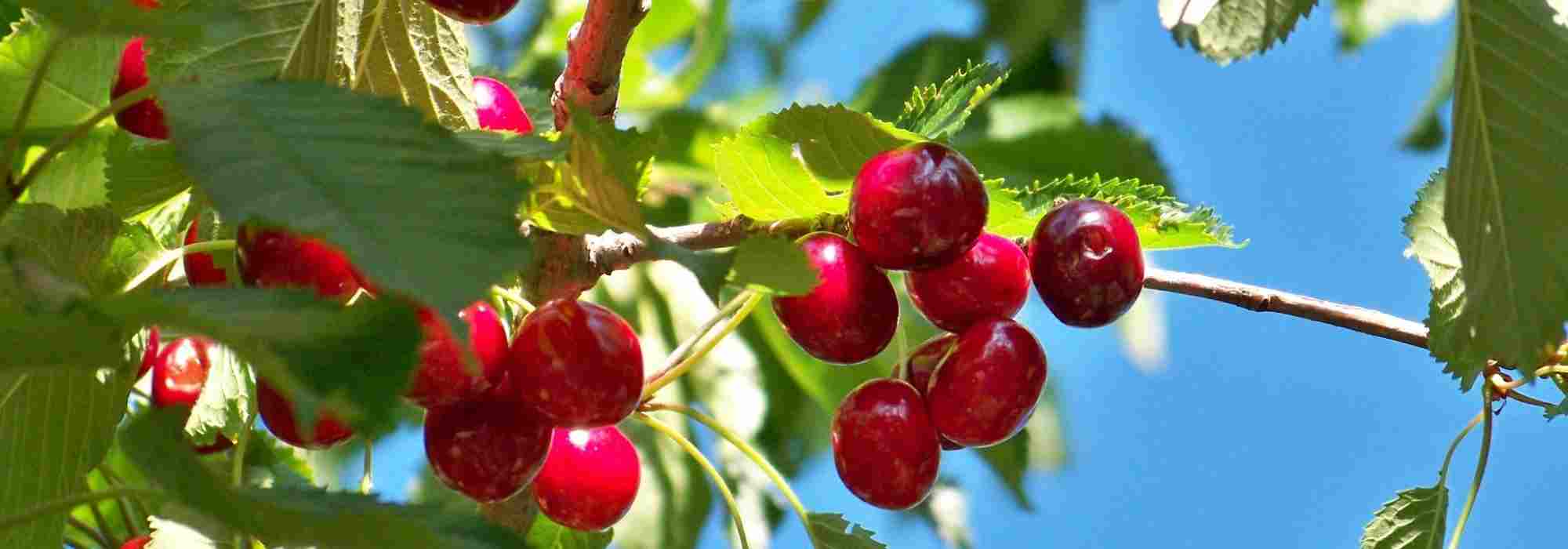
Self-fertile cherry trees, perfect for small gardens
Our tips for enjoying cherries in a small space, even on a balcony or terrace
Contents
Biting into a ripe cherry, freshly picked from your cherry tree, is pure bliss for a gardener. However, this simple pleasure isn’t accessible to everyone. Indeed, traditional cherry trees require cross-pollination to bear fruit, meaning you need at least one compatible second tree to ensure a generous harvest. A constraint that can be overcome with self-fertile cherry trees. Capable of pollinating themselves, these cherry tree varieties allow you to enjoy cherries even in a small garden, courtyard, balcony, or terrace.
Discover self-fertile cherry trees, their characteristics and cultivation, along with our selection of the best varieties.
Pollination of cherry trees: how does it work?
The pollination of fruit trees often depends on cross-pollination. This generally means that, to produce fruit, a fruit tree needs to have another fruit tree of a different species nearby (in your garden or a neighbour’s garden). Note that there are good pollinator varieties whose pollen can pollinate several other varieties, and poor pollinator varieties. And it’s not just a matter of planting two varieties side by side to get fruit… The pollinator variety must be compatible with the variety to be pollinated!
Cherry trees are fruit trees particularly affected by this cross-pollination. For example, the ‘Burlat’ variety can be pollinated by ‘Early Rivers’, ‘Van’ or ‘Napoléon’ but is incompatible with ‘Moreau’. And ‘Napoléon’ can be pollinated by ‘Hedelfingen’ but is incompatible with ‘Marmotte’. Suffice to say, it’s essential to consider this when planting a cherry tree in your garden.
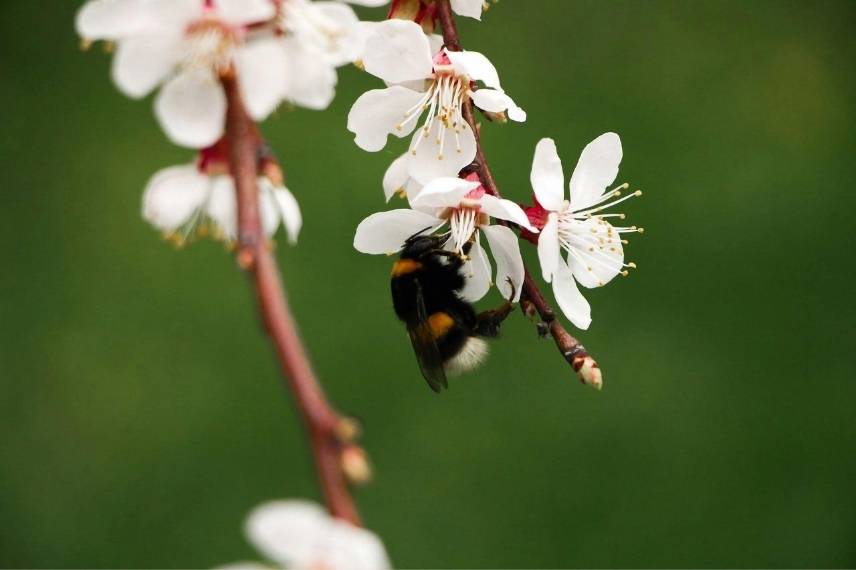
Most cherry trees fruit thanks to cross-pollination
Adding to this complexity is the fact that there are different species of cherry trees:
- The wild cherry (Prunus avium) which produces sweet cherries, bigarreaux and guignes. Varieties of this species are generally self-sterile, meaning they require cross-pollination
- The sour cherry (Prunus cerasus) which produces tart cherries, amarelles and griottes. These species are self-fertile, meaning they can manage pollination on their own
- The hybrids between the two previous species which produce true cherries. These are self-sterile species, so cross-pollination is essential.
Why are self-fertile varieties ideal for small spaces?
There’s an obvious answer to this question! Planting a self-fertile variety avoids headaches. Let’s face it, cross-pollination can be quite complex with cherry trees. You need a good understanding of the different species to hope for a decent harvest of cherries.
But growing a self-fertile cherry tree meets other needs, particularly for those without a large orchard or extensive grounds. Thanks to its ability to self-pollinate, a self-fertile cherry tree doesn’t require another cherry tree nearby. A single tree can provide a satisfactory harvest, which is a major advantage when space is limited – especially in small gardens where every square metre counts. By choosing a self-fertile cherry tree, you free up space to grow other fruit trees, a vegetable patch or ornamental plants. 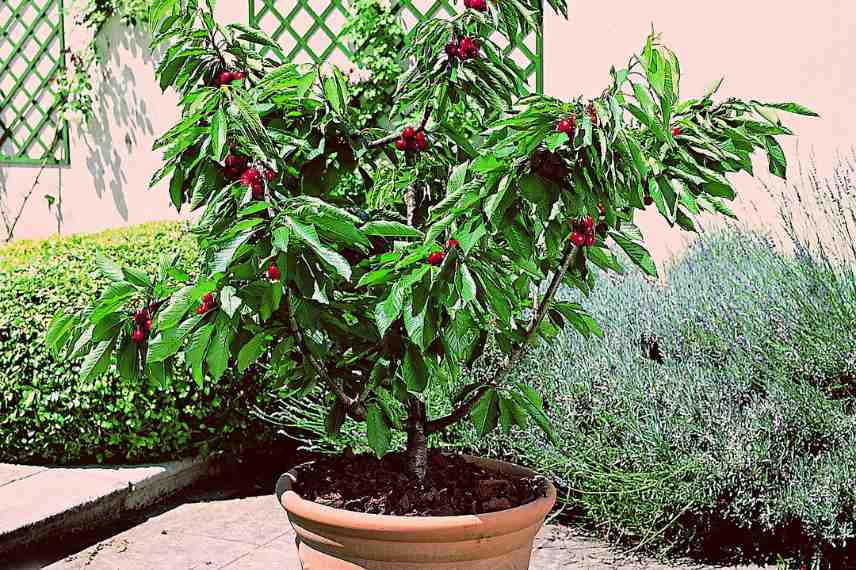
Self-fertile cherry trees also adapt very well to container growing, for example in a courtyard or patio, on a spacious balcony or generous terrace with good sun exposure. This means you can harvest your own cherries even in an urban setting! Some cultivars, grafted onto dwarf or semi-dwarf rootstocks, remain compact while offering beautiful flowering and abundant fruiting. For an experienced gardener, this opens up opportunities for sophisticated cultivation techniques like espalier or goblet pruning, optimising both the tree’s structure and fruit production.
Finally, with self-fertile cherry trees, you avoid problems caused by a rainy spring or poor flowering synchronisation.
Our selection of the best self-fertile cherry tree varieties
You can grow a self-fertile cherry tree in a small garden, on a balcony or terrace, provided you choose the right varieties. Discover our selection to suit everyone’s needs.
Self-fertile bigarreau cherries
Bigarreau cherries are prized for their firm flesh and high sugar content. While most well-known varieties require cross-pollination, some are self-fertile, allowing you to enjoy beautiful cherries without needing a second tree:
- ‘Summit’: A variety with large, deep bright red fruits, sweet, firm and crunchy. Its early flowering occurs in late March for a harvest from June. Hardy down to -20°C, it can be planted anywhere. It is productive and disease-resistant. At maturity, it forms a tree 6m tall with a 4m spread.
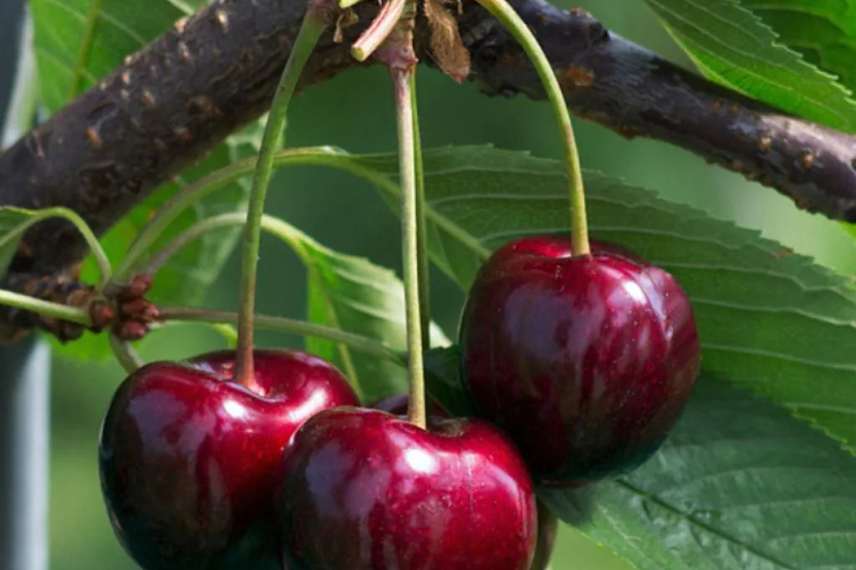
The ‘Summit’ bigarreau cherry tree
- ‘Sunburst’: A variety with large, relatively light red fruits, slightly striped, moderately sweet, tender and juicy. This semi-late variety flowers between late March and late April and fruits in June-July. Dimensions: 4m in all directions at maturity.
- ‘Bigarreau de la Saint-Jean®’: A variety created by Delbard that produces large, dark red, very sweet cherries. Late flowering in April, generous fruiting in June.
- ‘Staccato’: A late-maturing variety that produces firm, deep red cherries. Flowering occurs in April, with harvest from mid-June to mid-July.
Sour cherries or hybrid guignes
- ‘Kelleriis 16’: A medium-growing cherry tree (5m x 5m) with late fruiting. It produces large red cherries, sweet and tangy. This is a productive cherry tree with low disease susceptibility.
- ‘Belle Magnifique’: A late variety, born from cross-breeding between a bigarreau cherry and a sour cherry. It offers medium-sized, bright and shiny red cherries. Harvest begins in mid-July.
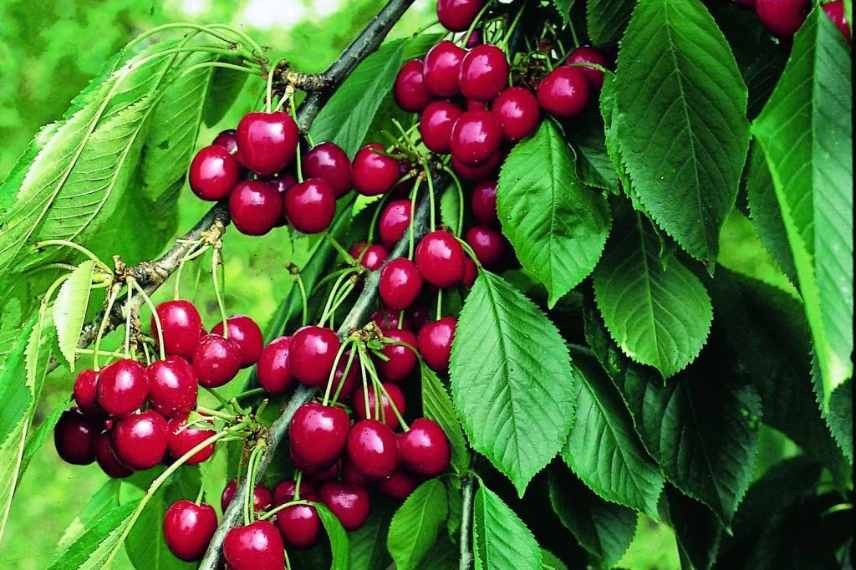
The ‘Belle Magnifique’ cherry tree
- ‘Allegria’: A variety created by Delbard, with late flowering and red fruits with purple flesh, sweet and tangy. This variety is very disease-resistant but can reach 6-7m in all directions.
Dwarf cherry trees
These dwarf cherry trees can be grown in pots, as they rarely exceed 2m in all directions, yet still offer a generous cherry harvest.
- ‘Fruit Me® Cherry Me Lapins’: A variety that produces large, heart-shaped, bright red cherries from the first year, with juicy, crunchy, sweet and subtly tangy flesh. An easy-care cherry tree that requires no pruning. In a pot, it won’t exceed 1.50m in height with a 1m spread.
- ‘Carmine Jewel’: A variety that produces small sour cherries with soft, sweet flesh, perfect for baking.
- ‘Piémont’: A variety with luminous red cherries, sweet with a hint of acidity. Harvest in June-July.
- ‘Cherry Baby’: A recent variety offering crunchy, juicy cherries, both sweet and tangy, with bright red skin.
Columnar cherry trees
Columnar cherry trees are perfect for small spaces. They don’t exceed 2m in height and have a narrow spread.
- ‘Sylvia’: A variety with slightly elongated, bright red fruits and sweet, crunchy flesh. Flowers in April, harvest in July-August.
- ‘Shangai’: A variety with very dark red cherries, crunchy and sweet. Its pale pink flowers appear in April. It can reach 4m in height in open ground but won’t exceed 60cm in width.
- ‘Hong Kong’: A white-flowered variety that produces beautiful bright red cherries, crunchy and sweet. It has the same characteristics as ‘Shangai’.
How to plant and care for cherry trees in a small garden?
In a small garden, cherry trees require optimal planting and care to ensure their health and productivity:
- The chosen location is crucial, as the cherry tree needs sun to fruit. Similarly, it should be planted sheltered from cold winds. The soil must be deep, rich and humus-bearing, perfectly drained
- For container planting, use a pot of at least 50 to 60 litres, with drainage holes at the bottom and a layer of clay pebbles or gravel. The substrate should consist of garden soil, mature compost and sand for drainage
- Maintenance focuses on regular watering during dry periods (more frequent if grown in a container) and pruning. Light pruning, in late winter or just after harvest, aims to open up the branches and promote fruiting on short shoots. Most dwarf cherry trees require little to no pruning.
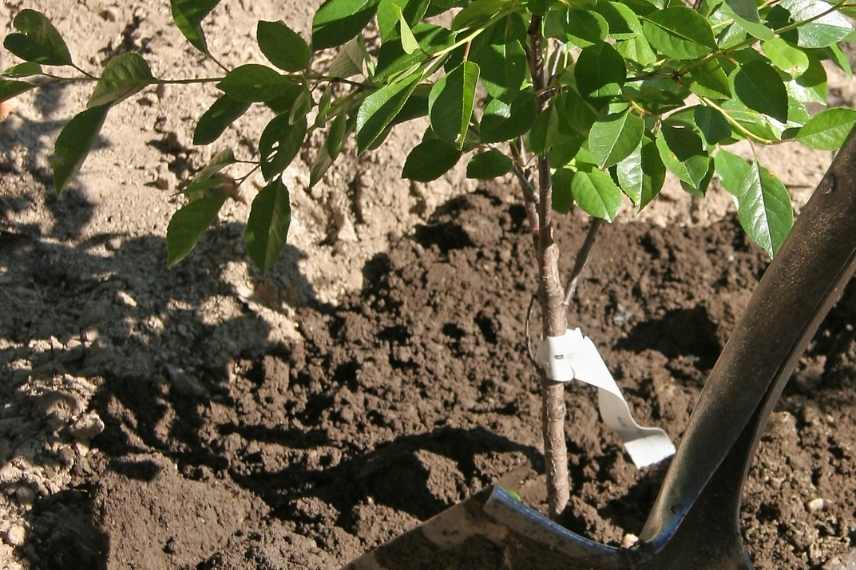
- Apply a little compost in spring at the base of the cherry tree
- Mulching helps retain moisture in the soil
- Monitoring for diseases and parasitic pests is essential to act quickly and prevent their spread.
- Subscribe!
- Contents
































Comments